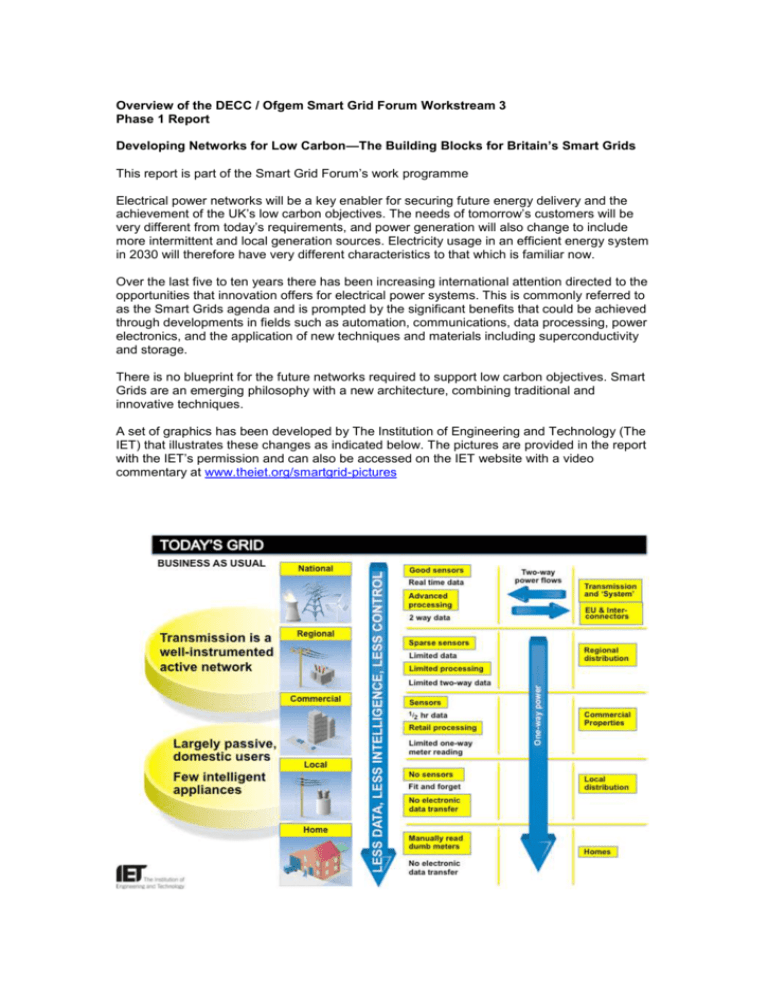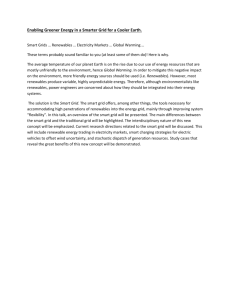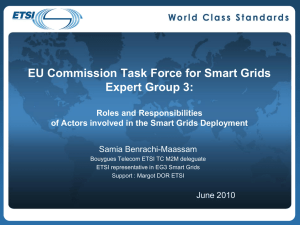Overview of the SGF Work Stream 3 Phase 1 Report
advertisement

Overview of the DECC / Ofgem Smart Grid Forum Workstream 3 Phase 1 Report Developing Networks for Low Carbon—The Building Blocks for Britain’s Smart Grids This report is part of the Smart Grid Forum’s work programme Electrical power networks will be a key enabler for securing future energy delivery and the achievement of the UK’s low carbon objectives. The needs of tomorrow’s customers will be very different from today’s requirements, and power generation will also change to include more intermittent and local generation sources. Electricity usage in an efficient energy system in 2030 will therefore have very different characteristics to that which is familiar now. Over the last five to ten years there has been increasing international attention directed to the opportunities that innovation offers for electrical power systems. This is commonly referred to as the Smart Grids agenda and is prompted by the significant benefits that could be achieved through developments in fields such as automation, communications, data processing, power electronics, and the application of new techniques and materials including superconductivity and storage. There is no blueprint for the future networks required to support low carbon objectives. Smart Grids are an emerging philosophy with a new architecture, combining traditional and innovative techniques. A set of graphics has been developed by The Institution of Engineering and Technology (The IET) that illustrates these changes as indicated below. The pictures are provided in the report with the IET’s permission and can also be accessed on the IET website with a video commentary at www.theiet.org/smartgrid-pictures The report, translates the impact of UK’s future energy scenarios into key strategic directions for network development, identifying the needs for network expansion and the opportunities for smart grid techniques to drive cost-efficiency and deliver new services. It considers the enablers for change, including the necessary development of commercial and regulatory frameworks. It focuses on 2020 and 2030, and casts a forward look towards 2050 to consider the enablers for change, including the necessary development of commercial and regulatory frameworks. In addition, the report is structured to deliver key messages that will support Ofgem, DECC and the network companies in the first stage of the next eight year regulatory price control, known as ED1 (2015-2023), and the companies regulatory business plan preparation for this period. The methodology used for the analysis identifies the implications for networks of the national low carbon scenarios and develops responses that include a range of smart grid techniques. This wide range of innovative options has been consolidated into a smaller number of “Solution Sets”. These summarise the building blocks that can be used to augment network investment. Insights have been provided by a range of contributors that include the energy storage community, technology specialists, suppliers and academia, along with the companies responsible for the distribution and transmission networks. This has ensured that an appropriate level of technology development and ambition is embedded in the strategy. Customer requirements, affordability and the extent of consumer engagement are key factors that have been incorporated. SCENARIOS The report concludes that future network architectures are likely to develop in stages with a first phase, termed Smart Grid 1.0, using largely established innovation techniques in an increasing number of projects. In the longer term a Smart Grid 2.0 stage will incorporate more ambitious innovation and the scale of deployment will become more extensive, progressively and systematically populating the network in response to local needs. A periodic review process is recommended to reaffirm the energy scenario contexts, to ensure a Systems Engineering approach, and maintain ambitions for the ultimate pathway to a cost-effective and secure low-carbon future. There is inevitable uncertainty around the extent and timing of the increase in electricity usage, and also the characteristics of demand and generation requirements. Hence future network development needs to embrace this uncertainty within the technical, commercial and process characteristics. A set of key structural principles is proposed to support solutions that are flexible and scalable, that utilise functional designs and open system architectures, and also address the rising data volumes and associated complexity. A Phase 2 project is currently in progress that addresses quantitative modelling of the network developments including, for example, the likely costs of the Solution Set options provided in this report and the consequences of clustering effects. This is founded on the agreed energy scenarios and shared assumptions being developed by the Smart Grid Forum’s Work stream 1, and is also closely associated with the Work stream 2 development of a cost benefit assessment for the UK Smart Grid. In summary: • The potential impact of future GB energy scenarios on power networks is material. • The challenge ahead is technically demanding and of a scale not seen in 50 years • Innovative products and architectures (smart grids) offer cost-effective solutions • Innovation will need to be adopted in conjunction with traditional network investment • Technology alone will not deliver the required outcomes: Commercial and Regulatory frameworks, and consumer engagement will be key enablers • Enabling actions for the short term will accelerate advanced functionality in later years • Customers can expect attractive new services and products, including helpful energy automation to obtain the best deals and services • A number of points identified for further action are set out in Chapter 10. The report structure uses a ten step approach:Step 1 - Scenarios Work stream 1 of the Smart Grids Forum will in due course provide definitive scenario assumptions and is likely to have a significant effect on the quantification work in the Phase 2 report. The analysis has been progressed using other published scenario information, the Government’s Carbon Pathways, and an analysis by Redpoint Consultants, commissioned by the ENA. Step 2 – Network Implications The impact of key elements in the scenarios has been assessed on a broad scale (None /Moderate /Challenging /Significant) for the two sectors of Transmission and Distribution, and for three time horizons within each – Investment Planning, Operational Planning, and Real Time Operation. Step 3 – Consumer Implications This report addresses consumer issues at each step but does not claim to have been exhaustive; there remains important work to take forward in this area. It is evident that the changes ahead will both need to engage the hearts and minds of consumers and the wider public, and can be expected to bring significant consumer benefits. Step 4 – Network Responses The opportunities for emerging and future technologies and techniques have been matched to the challenges set out for each network sector and timescale. Step 5 – Consolidation It is important to consolidate the multiplicity of technologies and techniques so that a manageable framework is established. Step 6 – Technology Futures Views have been canvassed widely to capture emerging technology opportunities. This approach cannot be exhaustive and there will be opportunities for high value innovation that have not yet been identified. The approach in the report is to establish an open framework for change that will be capable of adaptation as new opportunities emerging internationally. Step 7 – Uncertainty & Complexity These characteristics will accompany the power sector as it enters a time of radical change. It will be important that responses and methodologies are ‘designed-in’ and this report commences the process with a number of generic principles and engineering good practice pointers. Step 8 – Management Considerations The network companies will need to respond to a number of issues at a corporate level and these are explored briefly. Issues include: risk profiles, partnering requirements, skills and know-how, and business planning tools and techniques. Step 9 – Key Enablers Recognising that the technology alone is neither the sole driver for change, nor able to deliver successful outcomes on a stand alone basis, this step of the analysis examines key enablers for: Technology, Consumers & Third Parties, Legislation & Regulation, and for Technology Development. Step 10 – Deliverables Specific action points have been identified for the network companies and an agenda for consideration is offered to third parties. In addition, it has been the aim of this analysis to provide information that will assist ED1 business planning submissions. The European and wider context is considered, particularly related activities and timing.






